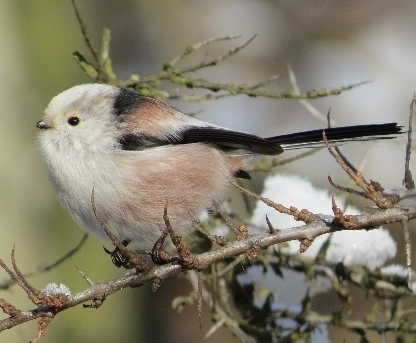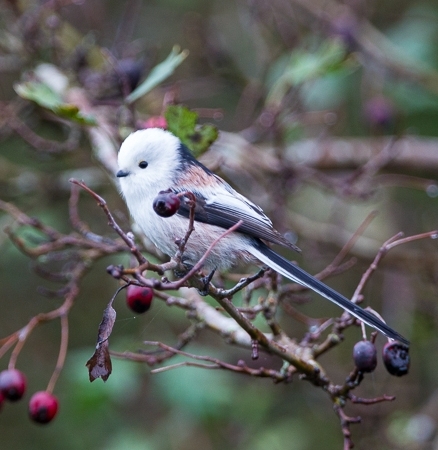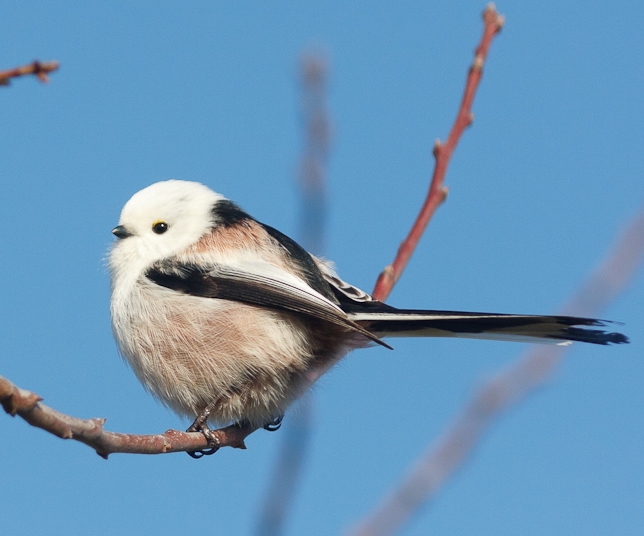Strié, rayé, blanc ou blanchâtre : comment distinguer les phénotypes de la Mésange à longue queue ?
La Mésange à longue queue est une espèce très répandue que l’on peut observer toute l’année en Suisse. Les oiseaux appartiennent habituellement à la sous-espèce europaeus, qui se distingue par un large bandeau foncé sur les côtés de la tête. Des Mésanges à longue queue présentant les caractères de la sous-espèce caudatus, à tête blanche, sont observées en petit nombre entre fin octobre et mi-avril en Suisse, notamment depuis l’invasion de l’hiver 2010/2011, au cours duquel 325 ind. ont été homologués par la Commission de l’avifaune suisse CAvS. Depuis cet afflux, les observations sont devenues plus régulières, si bien que la sous-espèce caudatus n’est maintenant plus soumise à homologation. Cependant, il existe de nombreuses formes intermédiaires entre les deux sous-espèces et dans les livres d'identification actuels, le problème de l’identification des Mésanges à longue queue à tête blanche est insuffisamment traité. De nombreux observateurs ne sont donc pas conscients que la couleur de la tête ne suffit pas à elle seule pour identifier la sous-espèce caudatus. Cet article, adapté de ornitho.de, vous propose donc de faire le point sur le sujet, pour vous aider à reconnaître et documenter les différents phénotypes.
Quatre types peuvent être distingués (voir photos ci-dessous) :
Les types 1 à 3 sont signalés sous "Mésange à longue queue" en indiquant les différents types dans les remarques (exemple : "troupe composée de 8x type EE, 2x type CE"). Le type 4 est le seul qui peut être signalé sous "Mésange à longue queue (A. c. caudatus)".
Important : il n'est bien entendu pas nécessaire d'attribuer un type à chaque Mésange à longue queue observée. Si aucune affectation n'est possible, ne mettez rien dans les remarques.
Quels oiseaux appartiennent au "Type caudatus" ?
Selon la littérature actuelle, les Mésanges à longue de la sous-espèce caudatus doivent présenter les caractéristiques suivantes:
Veuillez ne signaler sous caudatus que les individus absolument typiques!
De nombreuses Mésanges à longue queue qui semblent avoir la tête blanche à première vue présentent en fait, si on regarde bien, des zones sombres sur la tête ou des mouchetures grises dans la région des parotiques et de la nuque (c'est-à-dire qu'ils appartiennent au type CE). Sur le terrain, ces caractéristiques ne sont pas toujours faciles à voir chez ces petits oiseaux toujours en mouvement. Par conséquent, en présence d’individus à tête blanche, il faut toujours rechercher les autres critères décrits ci-dessus. L’idéal est de les photographier ou de décrire les détails observés dans les remarques.
Si vous n'êtes pas sûr de l’identification, n'hésitez pas à envoyer vos photos à obs@ornitho.ch.
Afin de reconnaître les différents types des Mésanges à longue queue observées, ornitho.de a sélectionné quelques photos:
Type EE:
    |
Type EC:
    |
Type CE:
    |
Type "caudatus":
    |
Les articles suivants sont très utiles pour l'identification et d’autres informations générales sur les sous-espèces de la Mésange à queue longue :